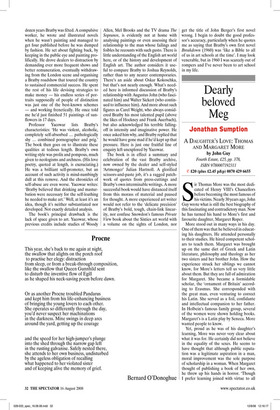Dearly beloved Meg
Jonathan Sumption
A DAUGHTER’S LOVE: THOMAS AND MARGARET MORE by John Guy Fourth Estate, £25, pp. 378, ISBN 9780007192311 ✆ £20 (plus £2.45 p&p) 0870 429 6655 Sir Thomas More was the most dedicated of Henry VIII’s Chancellors before becoming the most famous of his victims. Nearly 30 years ago, John Guy wrote what is still the best biography of this fascinating and contradictory man. Now he has turned his hand to More’s first and favourite daughter, Margaret Roper.
More stood out in many ways in his day. One of them was that he believed in educating his daughters. He attended personally to their studies. He hired competent scholars to teach them. Margaret was brought up on the same diet of Greek and Latin literature, philosophy and theology as her two sisters and her brother John. How the experience struck her siblings we cannot know, for More’s letters tell us very little about them. But they are full of admiration for Margaret. She became a formidable scholar, the ‘ornament of Britain’ according to Erasmus. She corresponded with the great man, even venturing to correct his Latin. She served as a foil, confidante and intellectual companion to her father. In Holbein’s famous family group, several of the women were shown holding books. Margaret’s is a Latin play by Seneca. More wanted people to know.
Yet, proud as he was of his daughter’s learning, More was never very clear about what it was for. He certainly did not believe in the equality of the sexes. He seems to have thought that although public reputation was a legitimate aspiration in a man, moral improvement was the sole purpose of scholarship in a woman. When Margaret thought of publishing a book of her own, he threw up his hands in horror. ‘Though I prefer learning joined with virtue to all the treasures of kings,’ he wrote to the young lady’s tutor, ‘yet renown for learning, if you take away moral probity, brings nothing else but notorious and noteworthy infamy, especially in a woman.’ Margaret did in fact publish, at the age of 20, a translation of Erasmus’s meditations on the Lord’s Prayer. But she had enough respect for her father’s sensitivities to do it anonymously. It is difficult to avoid seeing in this ambivalence the possessiveness of clever fathers in every age for their talented daughters. Margaret had to resign herself to cultivating her talents in private.
As a result, she passed most of her life under her father’s shadow. She lived in his home, even after her marriage to the shallow William Roper. She washed More’s penitential hair shirt for him, the only member of the family who was allowed to know of its existence. She chose her friends from within his circle. Her life is known mainly from her father’s letters. It was only in the final, tragic months of More’s life, that the relationship was reversed, as the father came to depend increasingly on the daughter.
More was arrested on 13 April 1534 after refusing to swear the oath required by the Act of Succession, which enjoined every subject to affirm that Henry VIII’s marriage to Anne Boleyn was valid. More pleaded his conscience, but he was certainly no believer in liberty. Had he not himself led police raids against the printers and owners of forbidden books and personally signed the death warrants of heretics, as some of his interrogators pointed out? More conceded the point and took his stand not on freedom but on authority, by which he meant the authority of the universal Church. Parliament could make what arrangements it pleased for Anne’s offspring to inherit the throne, for that was a purely secular matter. But the validity of a marriage depended on universal laws which the Pope could waive but no national ruler could change. He knew what to expect. To the Duke of Norfolk, who had warned him that ‘the wrath of the Prince is death’, More replied: ‘Is that all, my lord? Then in good faith is there no more difference between your grace and me, but that I shall die today and you tomorrow.’ In fact, More survived until 6 July 1535, when he was beheaded on Tower Hill after a brief trial in Westminster Hall. On the scaffold, he declared that he died ‘the King’s good servant, but God’s first.’ More was sustained during his 15 months in the Tower by Margaret’s visits and then, when the government stopped them, by the letters which they secretly exchanged. More’s are among the finest things that he ever wrote, many of them scratched with charcoal saved from the fire and smuggled out by his servant. Margaret’s letters back match them for warmth and humanity. Beyond the walls of the Tower, the rest of More’s family succumbed one after the other to the pressure of events and ambitions. As for Margaret, she set about preserving as many as possible of his writings and personal letters, and collected the materials which her husband would one day use to write his biography. She bribed the guards to let her retrieve his head from its spike on London Bridge, and had it placed in her coffin when she died nine years later. Henry VIII’s minister Thomas Cromwell was well informed about her activities, and called her before the Council to answer for them. But he took no action against her, according to the only surviving account, ‘because she was a woman’.
John Guy has written an admirable account, based partly on the reworking of material in his earlier books, but also on a substantial amount of new research in the archives and obscurer incunabula of the period. The result is a minor masterpiece, so good that one can even forgive the author’s affected forays into demotic English (‘don’t’ and ‘wouldn’t’ for ‘did not’ and ‘would not’, etc.).



























































 Previous page
Previous page